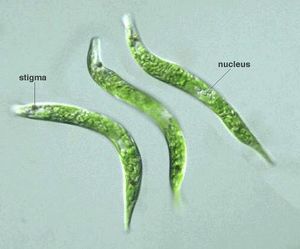Euglena mutabilis
Classification
Kingdom: Protozoa
Phylum: Euglenophycota -euglenoids, euglenes
Class: Euglenophyceae
Order: Euglenales
Family: Euglenaceae
Genus: Euglena Ehrenberg. 1838
Species: Euglena mutabilis
Variety: Euglena mutabilis var. mainxi
Variety: Euglena mutabilis var. mutabilis
Euglena mutabilis
Description and Significance
Euglena mutabilis is a single celled gliding Euglena with singular flagella. Although worm like, it rarely swims and has many disk-shaped plastids (10 to 100). [1] It was one of the first microorganisms discovered in the acidic mine waste of the Berkeley Pit in Butte, Montana. The ph of the Berkeley pit is between 2.5 and 3 and has been previously believed to have be uninhabitable. [2] Due to this discovery, and many others, it has been determined that Euglena mutabilis can survive and even thrive in highly acidic environments and can thus be described as an extremophile. Like other microorganisms found in the Berkeley pit, Euglena mutabilis may have useful byproducts. Specifically, researchers believe that Euglena mutabilis may help in environmental cleanup efforts due to signs that it may be able to consume metals. [3]
Structure, Metabolism, and Life Cycle
Euglena mutabilis is 70-170 μm long and 25-36 μm wide. The cell body is cylindrical with posterior tapering. It's singular flagella is longer than it's body and it's stigma is about 7 μm in diameter. In addition to it's stigma, the Euglena mutabilis has many fusiform chloroplasts and it's nucleus is posterior. [4] Euglena mutabilis is an autogenic and an allogenic engineer which mean that it transforms it's environment through it's physical structure as well as by the byproducts and materials that it produces. It is believed that Euglena mutabilis enriches it's environment by producing oxygen by photosynthesis that other microorganisms can utilize as well as precipitate Fe to create stable substrates for other microorganisms to inhabit. It creates a biofilm that allows for increased oxygenation of surrounding environments. [5]
Ecology and Pathogenesis
It's natural habitat is landlocked aquatic environments. [6] There is no consensus of whether Euglena causes diseases in human, not to mention specifically Euglena mutabilis. Requires additional research.
References
[1] Amaral Zettler, Linda, and David Patterson. "Euglena Mutabilis." Micro*scope. Cu*star, n.d. Web. 21 July 2013. <http://starcentral.mbl.edu/microscope/portal.php?pagetitle=assetfactsheet&imageid=326>.
[2]"Berkeley Pit and BMF Operable Unit." Montana Bureau of Mines and Geology. Montana Gov, 21 Dec. 2011. Web. 21 July 2013. <http://www.mbmg.mtech.edu/env/env-berkeley.asp>.
[3]Edwin, Dobb. "New Life in a Death Trap." Discover 1 Dec. 2000: n. pag. Discover Magazine. 1 Dec. 2000. Web. 21 July 2013. <http://discovermagazine.com/2000/dec/featnewlife>.
[4]"Protist Images: Euglena Mutabilis." Protist Information Server. N.p., n.d. Web. 21 July 2013. <http://protist.i.hosei.ac.jp/PDB/Images/Mastigophora/Euglena/mutabilis/>.
[5]Hasiotis, Stephen, Sandra Brake, and Kathy Dannelly. "AN ECOSYSTEM ENGINEER IN ACID MINE DRAINAGE SYSTEMS, WESTERN INDIANA: EUGLENA MUTABILIS, AN OXYGENIC, PHOTOSYTHESIZING, STROMATOLITE-BUILDING PROTOZOAN MAKING LIFE POSSIBLE FOR OTHERS." Geomicrobiology Posters. N.p., 24 Apr. 2001. Web. 21 July 2013. <https://gsa.confex.com/gsa/2001NC/finalprogram/abstract_5546.htm>.
[6]Tanaka, Mari, Kenta Komatsu, and Tsutomu Iyobe. "Distribution of Euglena Mutabilis Schmitz and Its Function on the Formation of Chemical Environment in Acid Mine Drainage (AMD)." Chempro.env. Japan –Taiwan Joint International Symposium on Environmental Science and Technology, n.d. Web. 21 July 2013. <http://chempro.env.kitakyu-u.ac.jp/~aharaguchi/TanakaAbstract.pdf>.
[7]"Euglena Mutabilis." Integrated Taxonomic Information System. U.S., Canadian, Mexican Agencies, n.d. Web. 21 July 2013. <http://www.itis.gov/servlet/SingleRpt/SingleRpt?search_topic=TSN>.
Author
Page authored by Sophia Benson, student of Mandy Brosnahan, Instructor at the University of Minnesota-Twin Cities, MICB 3301/3303: Biology of Microorganisms.

